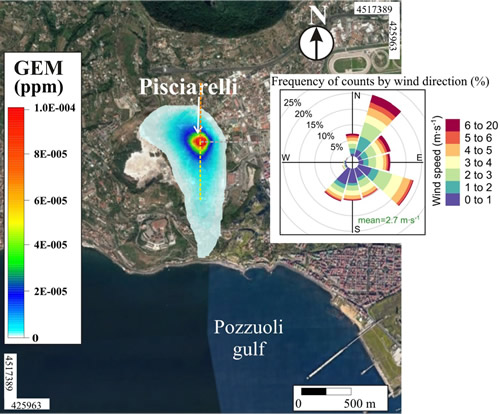First simultaneous mercury and major volatiles characterization of atmospheric hydrothermal emissions at the Pisciarelli’s fumarolic system (Campi Flegrei, Italy)

https://www.sciencedirect.com/science/article/pii/S0377027320303723?dgcid=coauthor
Anyone clicking on this link before December 04, 2020 will be taken directly to the final version of the article on ScienceDirect. No sign up, registration or fees are required.
- Share Link: https://authors.elsevier.com/c/1bvju1LkU3Vr1h
Bagnato E., G. Tamburello, D. Granieri, S. Caliro, F. D’Agostino, R. Avino, F. Capecchiacci, A. Carandente, A. D’Alessandro, C. Minopoli, A. Santi, M. Bitetto, E. Oliveri (2020).
Journal of Volcanology and Geothermal Research, 406, https://doi.org/10.1016/j.jvolgeores.2020.107074
Abstract
Hydrothermal systems with active surface expressions are important natural source of atmospheric mercury. Here we report on the first simultaneous assessment of gaseous elemental mercury (GEM) and major volatiles (H2S and CO2) fluxes from the fumarolic system of Pisciarelli, currently the most active at the Campi Flegrei caldera (CFc), Naples (Italy). This was achieved via a GPS-synchronized Lumex and MultiGAS survey which extends similar investigations reported elsewhere. GEM concentrations measured in the fumarolic emissions were consistently above background air level close to the degassing area (mean ~ 8 ± 3 ng m−3 on average) and ranged up to 12,000 ng m−3. Our data evidenced pulsed sequences of GEM increases in the fumarole plume, closely matched by temporally consistent increases in CO2 and H2S (r2 = 0.9), supporting the idea that major volatiles, such as CO2 acts as potential carrier in transporting GEM within the magmatic/hydrothermal systems. The slope of the best fit calculated for the dispersion of our data provides a GEM/CO2 molar ratio of 1.1 × 10−8 and a GEM/H2S of 5 × 10−6, respectively. These ratios are comparable to those reported for both low (~ 100 °C) and high-T (~ 250 °C) fumaroles from non-explosive volcanic/hydrothermal degassing systems elsewhere. We adopted an ad-hoc method that combines video footages and gas measurements to obtain high precision concentration maps of gas emissions used to estimate the total atmospheric GEM, CO2 and H2S flux of about 0.0113, 225059 and 511 t y−1, respectively. The human health risk assessment related to the GEM emissions at Pisciarelli, confirms that, except for the degassing fumarolic area, all the main sites affected by the plume dispersion, always remain well below the safe threshold recommended by the health authorities.


Devi effettuare l'accesso per postare un commento.